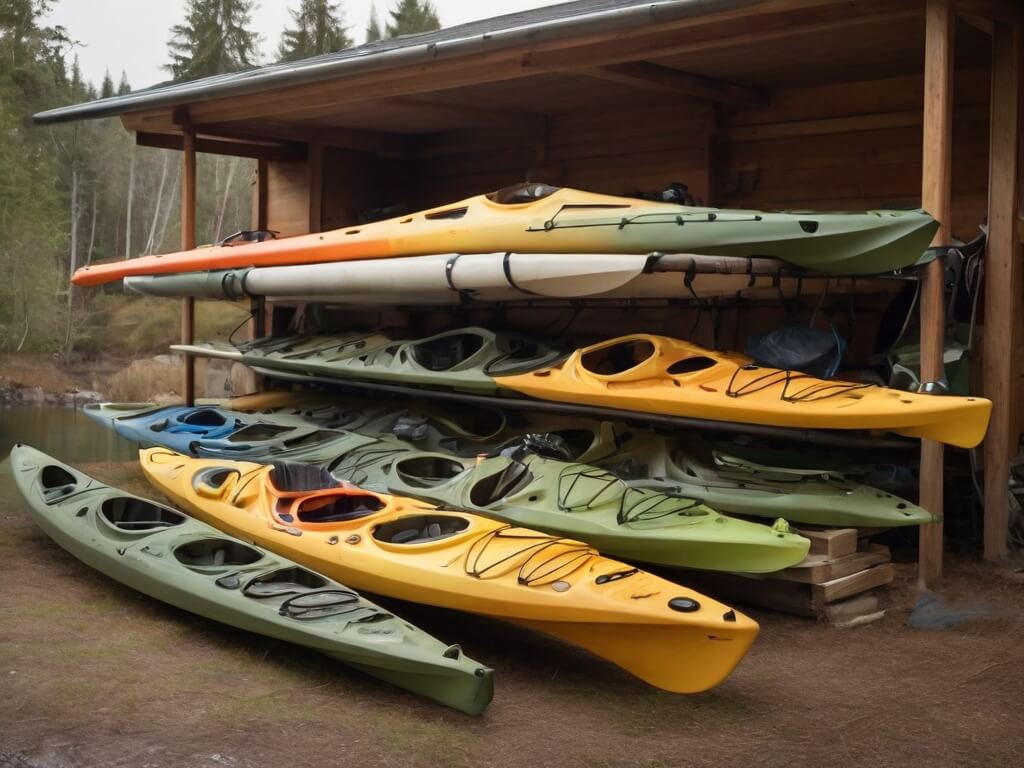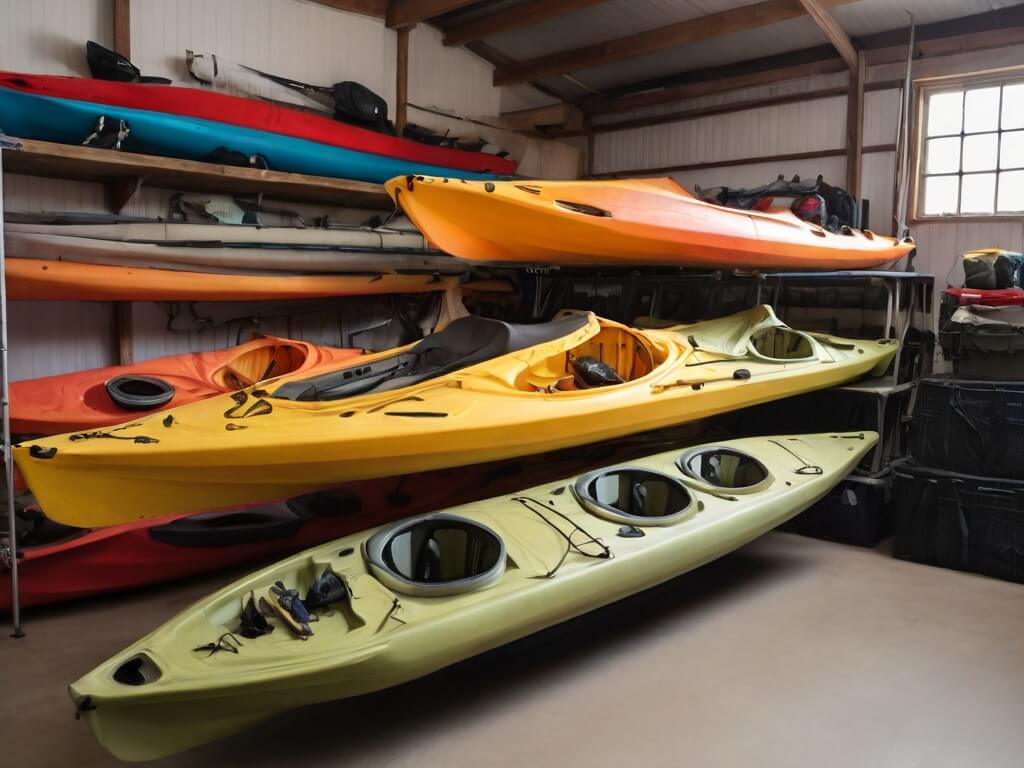How to Store a Fishing Kayak
Introduction
Kayaking is a watersport that requires immense patience and strong determination. While learning the tricks of kayaking is essential, another important element of kayaking is how to store a fishing kayak so that the kayaks can be used for a long period of time with little depreciation.
Following is a guide that delves deep into the art of storing your precious fishing kayak. Whether you’re a seasoned paddler or a novice exploring the world of kayaking, proper storage is paramount to ensuring the longevity and performance of your vessel. In this comprehensive guide, we’ll navigate through various storage solutions, tackle common challenges, and provide practical tips for safeguarding your fishing kayak.

The Basics: How to Store a Fishing Kayak
So, you’ve just returned from an exhilarating day on the water, and now you’re wondering, “How to store a fishing kayak?” Fear not, for we’re about to unravel the fundamental steps to keep your kayak in top-notch condition.
Proper storage begins with cleaning. Rinse off any saltwater or debris, paying special attention to the hull and cockpit. Use a mild detergent and a sponge to ensure a thorough cleaning.
Storing Position Matters
Ever wondered if your kayak should stand tall or lay low during storage? The answer lies in the material. For rigid kayaks, such as those made of polyethylene, it’s advisable to store them on their side. On the other hand, inflatable kayaks fare best when laid flat.
Remember, choosing the right storing position is not just about convenience; it’s about preserving the structural integrity of your beloved kayak.
Indoor vs. Outdoor Storage: Weighing the Options
Now that we’ve covered the basics, let’s tackle the age-old dilemma: indoor or outdoor storage.
The Indoors Advantage
Storing your fishing kayak indoors protects it from the elements, preventing prolonged exposure to UV rays and temperature extremes. A garage, shed, or dedicated storage space is ideal.
Embracing the Outdoors
For those without indoor space, outdoor storage becomes a necessity. Invest in a high-quality kayak cover to shield your vessel from the sun, rain, and snow. Ensure the cover is a UV-resistant fabric to combat the sun’s relentless rays.
Consider creating a designated outdoor storage area with a sturdy rack for added protection against the elements.

DIY Kayak Storage Solutions: Crafty and Cost-Effective
“Why spend a fortune on storage?” you ask. Fear not, frugal friends, for we have some DIY solutions that won’t break the bank.
1. Wall-Mounted Kayak Rack
Craft a simple yet effective wall-mounted kayak rack using sturdy brackets and padded arms. This elevates your kayak off the ground, freeing up valuable floor space.
2. Ceiling Hoist Systems
For those with limited floor space, a ceiling hoist system provides an ingenious solution. Elevate your kayak effortlessly with a pulley system, keeping it safe from accidental bumps.
DIY solutions not only save you money but also allow for customization based on your storage space and kayak dimensions.
Protective Measures: Kayak Covers
In the quest for optimal kayak storage, one cannot overlook the crucial role that kayak covers play. These protective shields act as the first line of defense against the elements, safeguarding your kayak from the sun’s harsh UV rays, rain, snow, and other environmental factors. Let’s delve into the details of why investing in a high-quality kayak cover is a must for every kayak enthusiast.
1. Material Matters: Choosing the Right Fabric
When selecting a kayak cover, the material is paramount. Opt for covers made from durable, UV-resistant fabric. Polyester and nylon are popular choices, as they provide excellent protection against sun exposure and are resistant to water, mildew, and abrasions.
Pro Tip: Look for covers with reinforced stitching for added durability and longevity.
2. Sizing for Success: Snug and Secure Fit
A well-fitted kayak cover is like a tailored suit for your vessel. Ensure that the cover fits snugly over your kayak without excessive slack. This prevents flapping in the wind and ensures maximum protection. Many manufacturers offer covers in various sizes to accommodate different kayak dimensions.
Remember, a snug fit not only protects your kayak but also prevents potential damage caused by loose-fitting covers.
3. UV Protection: Shielding from the Sun’s Wrath
The sun can be both a friend and a foe to your kayak. While you may enjoy basking in the sunlight on the water, prolonged exposure can lead to fading and deterioration of your kayak’s material. UV-resistant kayak covers act as a shield against the sun’s harmful rays, preserving the color and integrity of your vessel.
Did you know? UV damage can compromise the structural integrity of your kayak, making UV protection a crucial feature in a quality cover.
4. Waterproof Wonders: Keeping the Elements at Bay
Whether stored indoors or outdoors, exposure to moisture is a constant threat. A waterproof kayak cover creates a barrier, preventing rain, snow, and morning dew from seeping into your kayak. This protection is particularly vital for wooden or metal components, preventing rust and decay over time.
Investing in a cover with water-resistant properties ensures your kayak stays dry and ready for your next adventure.
5. Ventilation Vents: A Breath of Fresh Air
While keeping moisture out is essential, allowing trapped air to escape is equally crucial. Look for kayak covers equipped with ventilation vents. These vents prevent the buildup of condensation, reducing the risk of mold and mildew. Proper ventilation also helps maintain a stable environment inside the cover, preventing unpleasant odors.
Ventilation vents contribute to a healthier storage environment, ensuring your kayak is as fresh as the day you stored it.
6. Integrated Straps and Buckles: Securing the Fort
A secure fit is essential to prevent your kayak cover from transforming into a makeshift sail in strong winds. Covers with integrated straps and buckles provide an adjustable and secure fastening system. This not only keeps the cover in place but also adds an extra layer of protection against accidental removal.
Straps and buckles allow for customization, ensuring your cover stays put in various weather conditions.
7. Easy Access: Zippers and Openings
Convenience is key when accessing your kayak for impromptu paddling adventures. Opt for covers with strategically placed zippers and openings. These features allow you to reach specific areas of your kayak without having to remove the entire cover, saving you time and effort.
Zippers and openings make it easy to grab your gear, check on your kayak’s condition, or perform quick maintenance without a hassle.
8. Storage Bag Inclusions: Neat and Tidy Packing
Some kayak covers come with the added convenience of a storage bag. These bags not only make it easy to stow your cover when not in use but also contribute to overall organization. A neatly packed cover is more likely to be consistently used, ensuring your kayak receives the protection it deserves.
Factors that Affect Kayak Covers
High-Quality Kayak Covers
A well-fitted kayak cover acts as a shield against the elements. Look for one with UV protection and waterproof features to safeguard your kayak year-round.
Cockpit Covers for Added Defense
Prevent unwanted guests—like curious critters or falling debris—from entering your kayak by investing in a cockpit cover. This small accessory can make a significant difference.
Extend the lifespan of your kayak by combining both a kayak cover and a cockpit cover for comprehensive protection.
Additional Tips for Kayak Storage Success
Let’s explore some finer details to elevate your kayak storage game.
Climate Considerations
Adjust your storage strategy based on the climate of your region. For humid areas, consider using moisture-absorbing products to prevent mold and mildew.
Regular Inspection Routine
In addition to cleaning, establish a routine for inspecting your kayak. Check for any signs of damage, loose fittings, or pests that might have found their way into storage.
Lubricate Moving Parts
Ensure that hinges, rudders, and any other movable parts are well-lubricated before storing your kayak. This simple step prevents stiffness and ensures smooth operation when you’re back on the water.
FAQs: Addressing Your Concerns
Let’s dive into some common questions about storing fishing kayaks:
Q1: Can I store my kayak upside down?
Absolutely. Storing a kayak upside down helps maintain its shape and prevents warping.
Q2: Should I remove accessories before storage?
Yes, it’s advisable to remove accessories like paddles, seats, and fishing gear to prevent any damage during storage.
Q3: How often should I inspect my stored kayak?
Regular inspections are recommended, at least every few weeks, to identify and address any potential issues promptly.
Q4: Can I store my kayak in a vertical position?
While it’s possible for short durations, long-term vertical storage may lead to deformation. It’s best to store kayaks on their side.
Q5: Is it okay to hang a kayak by its handles?
Hanging a kayak by its handles can cause stress on the hull. Opt for specialized storage solutions like padded racks or hoists.
By addressing these FAQs, you’re not just storing your kayak; you’re nurturing its longevity and performance.

Conclusion: Navigating the Waters of Kayak Storage
In the vast sea of kayak storage options, finding the right fit for your fishing kayak is crucial. From DIY solutions to protective measures, this guide has equipped you with the knowledge to keep your kayak shipshape. Embrace these tips, and may your future paddling adventures be as smooth as the waters you navigate.
These useful measures not only protect your kayak when you are not using them but are also useful when you are transporting your kayak.
Remember, the key to a happy kayak is a well-thought-out storage plan. So, gear up, store up, and let the waters be your playground! Invest wisely, cover diligently, and let your kayak stand the test of time.

